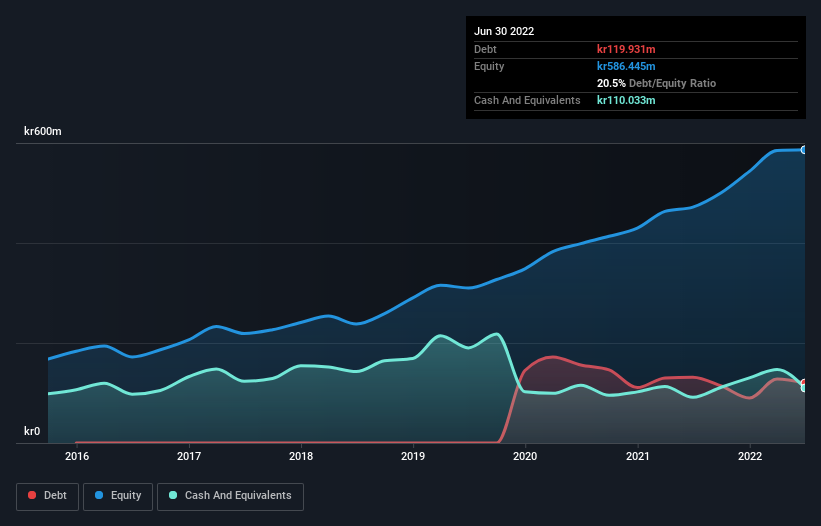
David Iben put it well when he said, 'Volatility is not a risk we care about. What we care about is avoiding the permanent loss of capital.' So it seems the smart money knows that debt - which is usually involved in bankruptcies - is a very important factor, when you assess how risky a company is. We note that CellaVision AB (publ) (STO:CEVI) does have debt on its balance sheet. But the real question is whether this debt is making the company risky.
When Is Debt A Problem?
Generally speaking, debt only becomes a real problem when a company can't easily pay it off, either by raising capital or with its own cash flow. In the worst case scenario, a company can go bankrupt if it cannot pay its creditors. However, a more usual (but still expensive) situation is where a company must dilute shareholders at a cheap share price simply to get debt under control. Of course, the upside of debt is that it often represents cheap capital, especially when it replaces dilution in a company with the ability to reinvest at high rates of return. When we think about a company's use of debt, we first look at cash and debt together.
Check out our latest analysis for CellaVision
What Is CellaVision's Debt?
As you can see below, CellaVision had kr119.9m of debt at June 2022, down from kr131.6m a year prior. However, it also had kr110.0m in cash, and so its net debt is kr9.90m.

How Strong Is CellaVision's Balance Sheet?
According to the last reported balance sheet, CellaVision had liabilities of kr123.0m due within 12 months, and liabilities of kr133.9m due beyond 12 months. On the other hand, it had cash of kr110.0m and kr124.3m worth of receivables due within a year. So its liabilities total kr22.5m more than the combination of its cash and short-term receivables.
Having regard to CellaVision's size, it seems that its liquid assets are well balanced with its total liabilities. So it's very unlikely that the kr7.18b company is short on cash, but still worth keeping an eye on the balance sheet. Carrying virtually no net debt, CellaVision has a very light debt load indeed.
In order to size up a company's debt relative to its earnings, we calculate its net debt divided by its earnings before interest, tax, depreciation, and amortization (EBITDA) and its earnings before interest and tax (EBIT) divided by its interest expense (its interest cover). This way, we consider both the absolute quantum of the debt, as well as the interest rates paid on it.
CellaVision has very little debt (net of cash), and boasts a debt to EBITDA ratio of 0.048 and EBIT of 31.3 times the interest expense. Indeed relative to its earnings its debt load seems light as a feather. On top of that, CellaVision grew its EBIT by 50% over the last twelve months, and that growth will make it easier to handle its debt. When analysing debt levels, the balance sheet is the obvious place to start. But ultimately the future profitability of the business will decide if CellaVision can strengthen its balance sheet over time. So if you're focused on the future you can check out this free report showing analyst profit forecasts.
But our final consideration is also important, because a company cannot pay debt with paper profits; it needs cold hard cash. So we always check how much of that EBIT is translated into free cash flow. In the last three years, CellaVision's free cash flow amounted to 48% of its EBIT, less than we'd expect. That weak cash conversion makes it more difficult to handle indebtedness.
Our View
The good news is that CellaVision's demonstrated ability to cover its interest expense with its EBIT delights us like a fluffy puppy does a toddler. And that's just the beginning of the good news since its EBIT growth rate is also very heartening. It's also worth noting that CellaVision is in the Medical Equipment industry, which is often considered to be quite defensive. Considering this range of factors, it seems to us that CellaVision is quite prudent with its debt, and the risks seem well managed. So we're not worried about the use of a little leverage on the balance sheet. Above most other metrics, we think its important to track how fast earnings per share is growing, if at all. If you've also come to that realization, you're in luck, because today you can view this interactive graph of CellaVision's earnings per share history for free.
If you're interested in investing in businesses that can grow profits without the burden of debt, then check out this free list of growing businesses that have net cash on the balance sheet.
New: AI Stock Screener & Alerts
Our new AI Stock Screener scans the market every day to uncover opportunities.
• Dividend Powerhouses (3%+ Yield)
• Undervalued Small Caps with Insider Buying
• High growth Tech and AI Companies
Or build your own from over 50 metrics.
Have feedback on this article? Concerned about the content? Get in touch with us directly. Alternatively, email editorial-team (at) simplywallst.com.
This article by Simply Wall St is general in nature. We provide commentary based on historical data and analyst forecasts only using an unbiased methodology and our articles are not intended to be financial advice. It does not constitute a recommendation to buy or sell any stock, and does not take account of your objectives, or your financial situation. We aim to bring you long-term focused analysis driven by fundamental data. Note that our analysis may not factor in the latest price-sensitive company announcements or qualitative material. Simply Wall St has no position in any stocks mentioned.
About OM:CEVI
CellaVision
Develops and sells instruments, software, and reagents for blood and body fluids analysis in Sweden and internationally.
High growth potential with solid track record.

